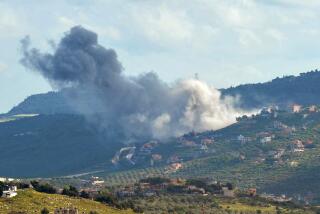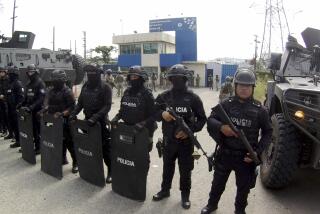Taliban offshoot blamed for assault on U.S. Embassy in Kabul
- Share via
Reporting from Kabul, Afghanistan — American and Afghan officials on Wednesday blamed a Taliban offshoot, the Haqqani network, for a marathon assault on the U.S. Embassy and the NATO force headquarters that killed 16 Afghans, including civilians and members of the security forces.
Eleven assailants died as well, the last of them shot Wednesday morning as Afghan police, backed by NATO helicopters, regained control of the unfinished high-rise structure the attackers used as their main staging ground.
The 20-hour siege paralyzed the city center, terrorized Kabul residents and sent hundreds of American embassy worker, military personnel and civilian NATO staff into hardened bunkers, where they remained for hours.
Senior U.S. officials sought Wednesday to downplay the significance of the attack, saying it had little or no military affect. But many Afghans, particularly those living or working in the vicinity of the strikes, spoke of a pervasive sense of insecurity in their daily lives.
Ghulam Mushtaba, a 29-year-old businessman, was caught in a crush of traffic as people fled the city center in the opening volleys of the attack. “I just abandoned my car and ran into a building looking for shelter,” he said.
A full day after the attack was launched, troubling questions remained as to how the insurgents managed to smuggle themselves and a startling array of lethal weaponry into the building site, which theoretically was under guard. From its upper floors, the 10-story structure offered a direct line of sight into the embassy and a variety of nearby government, military and diplomatic installations.
Afghan police said at least some of the attackers wore burkas, the long veils worn by many Afghan women, which helped them make their way through police checkpoints as they drove to the city center. But there also were suspicions that they may have had some form of assistance from within the ranks of the security forces.
U.S. Ambassador Ryan Crocker and Gen. John R. Allen, the U.S. Marine who commands Western forces here, both forcefully portrayed the attack as a sign of desperation on the insurgents’ part. In remarks distributed to international media, Crocker called it a “hard day for the embassy” but characterized the rocket fire as little more than “harassment.”
“A half a dozen RPG [rocket-propelled-grenade] rounds from 800 meters away — that isn’t Tet,” he said, referring to the 1968 campaign of surprise attacks by North Vietnamese and Viet Cong forces widely seen as turning the tide against U.S. forces in the Vietnam War.
Allen also described the siege as having “no operational impact whatsoever.” He said several coalition troops were injured, but none were killed.
No casualties were reported in the sprawling embassy compound.
Allen and other U.S. officials also made a point of praising the performance of Afghan forces, who are in charge of safeguarding the capital. But critics questioned why the siege went on for so many hours, and some witnesses reported some police firing wildly while civilians scattered and ran for cover.
The suspected involvement of the Haqqani network, which is based in Pakistan’s tribal areas, could heighten tensions with the Pakistani government, which has been accused of less-than-rigorous efforts to rein in insurgents who stage cross-border attacks in Afghanistan.
Crocker and Allen said the sophistication of the assault, which employed a team of suicide bombers who staged near-simultaneous strikes or attempted strikes in several parts of the city, pointed to Haqqani involvement.
The network, which sometimes works in concert with the Taliban, is most active in the eastern part of the country. Its fighters have been implicated in a string of assaults including a massive truck-bombing outside a U.S. base in Wardak province on the eve of commemorations of the 10th anniversary of the Sept. 11 attacks.
As has been the pattern in high-profile strikes, both sides used social media to try to shape their version of events. The Taliban sent out a steady stream of text messages describing confusion and disarray among Afghan security forces. Afghanistan’s Interior Ministry, meanwhile, announced the end of the siege on Twitter.
The audacious assault, which was the most serious strike against the embassy in the course of the nearly 10-year war, was apparently meant to shake public confidence in the ability of the Afghan police and army to safeguard the country.
The NATO force has begun handing over security responsibilities to Afghan troops, and American forces have begun a drawdown that will see the departure of 10,000 troops by the end of the year, about 10% of the current U.S. deployment.
“We will continue working with our Afghan partners toward transitioning security responsibility to them throughout the country,” Allen told reporters. “This is not the first such attack by the insurgents, and we do not expect that it will be the last.”
It was the third major attack in the capital in four months. Last month, insurgents besieged a British cultural center, and in June a team of gunmen and bombers invaded a luxury high-rise hotel.
Special correspondent Aimal Yaqubi contributed to this report.
More to Read
Sign up for Essential California
The most important California stories and recommendations in your inbox every morning.
You may occasionally receive promotional content from the Los Angeles Times.










